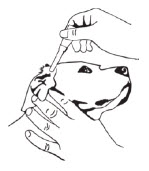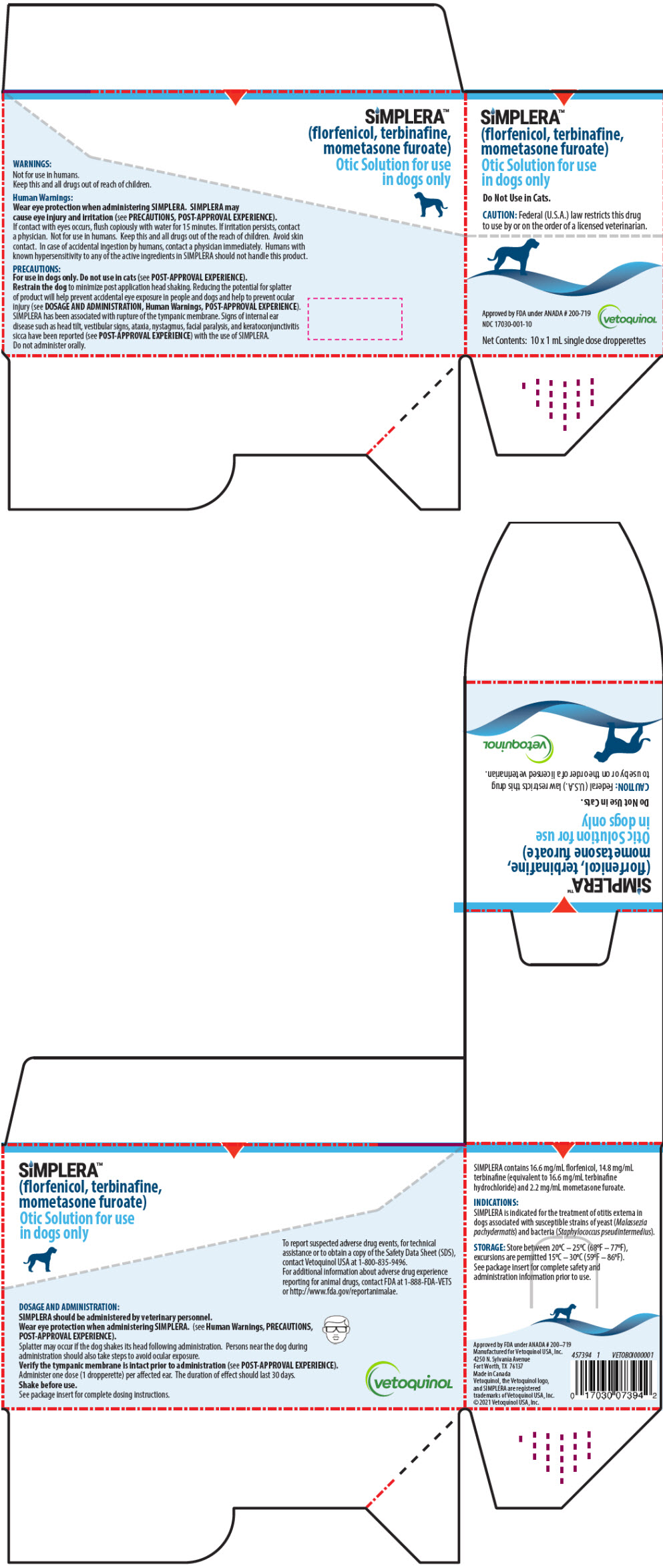Animal NDC 17030-001-10 Simplera Otic Solution
Florfenicol, Terbinafine, And Mometasone Furoate
Animal Product Information
Simplera Otic Solution Animal Product Labeling Information
The product labeling information includes all published material associated to a drug. Product labeling documents include information like generic names, active ingredients, ingredient strength dosage, routes of administration, appearance, usage, warnings, inactive ingredients, etc.
Table of Contents
- Other
- Warnings And Precautions
- Description:
- Indications:
- Dosage And Administration:
- Contraindications:
- Precautions:
- Adverse Reactions:
- Post-Approval Experience (2019):
- Information For Dog Owners:
- Pharmacology:
- Microbiology:
- Effectiveness:
- Animal Safety:
- Storage Information:
- How Supplied:
- Principal Display Panel - 1 Ml Dropperette Blister Pack Carton
Other
Otic Solution for use in dogs only
Do Not Use in Cats.
Antibacterial, antifungal, and anti-inflammatory
Human Warnings: SIMPLERA may cause eye injury and irritation (see PRECAUTIONS, POST-APPROVAL EXPERIENCE).
If contact with eyes occurs, flush copiously with water for at least 15 minutes. If irritation persists, contact a physician.
Humans with known hypersensitivity to any of the active ingredients in SIMPLERA should not handle this product.
Not for use in humans. Keep this and all drugs out of reach of children. Avoid skin contact. In case of accidental ingestion by humans, contact a physician immediately.
Manufactured for
Vetoquinol USA, Inc.
4250 N. Sylvania Ave
Ft. Worth, TX 76137
Made in Canada by
Vetoquinol N.-A. Inc.
Princeville, Québec, Canada
Vetoquinol, the Vetoquinol logo, and SIMPLERA are registered trademarks of Vetoquinol USA, Inc.
© 2021 Vetoquinol USA, Inc.
Approved by FDA under ANADA # 200-719
February 2022
457394 1
VETOFEU000001
Warnings And Precautions
CAUTION: Federal (U.S.A.) law restricts this drug to use by or on the order of a licensed veterinarian.
Description:
SIMPLERA contains 16.6 mg/mL florfenicol, 14.8 mg/mL terbinafine (equivalent to 16.6 mg/mL terbinafine hydrochloride) and 2.2 mg/mL mometasone furoate. Inactive ingredients include purified water, propylene carbonate, propylene glycol, ethyl alcohol, and polyethylene glycol.
Indications:
SIMPLERA is indicated for the treatment of otitis externa in dogs associated with susceptible strains of yeast (Malassezia pachydermatis) and bacteria (Staphylococcus pseudintermedius).
Dosage And Administration:
| SIMPLERA should be administered by veterinary personnel. Wear eye protection when administering SIMPLERA. (see Human Warnings, PRECAUTIONS, POST-APPROVAL EXPERIENCE). |
Splatter may occur if the dog shakes its head following administration. Persons near the dog during administration should also take steps to avoid ocular exposure.
Shake before use.
Verify the tympanic membrane is intact prior to administration. (see CONTRAINDICATIONS, PRECAUTIONS, POST-APPROVAL EXPERIENCE).
Administer one dose (1 dropperette) per affected ear.
| |
| |
| |
Contraindications:
Do not use in dogs with known tympanic membrane perforation (see PRECAUTIONS).
SIMPLERA is contraindicated in dogs with known or suspected hypersensitivity to florfenicol, terbinafine hydrochloride, or mometasone furoate.
Precautions:
For use in dogs only. Do not use in cats (see POST-APPROVAL EXPERIENCE).
Wear eye protection when administering SIMPLERA and restrain the dog to minimize post application head shaking. Reducing the potential for splatter of product will help prevent accidental eye exposure in people and dogs and help to prevent ocular injury (see DOSAGE AND ADMINISTRATION, Human Warnings, POST-APPROVAL EXPERIENCE).
Proper patient selection is important when considering the benefits and risks of using SIMPLERA. The integrity of the tympanic membrane should be confirmed before administering the product.
Florfenicol, terbinafine, mometasone furoate otic solution has been associated with rupture of the tympanic membrane. Reevaluate the dog if hearing loss or signs of vestibular dysfunction are observed during treatment.
Signs of internal ear disease such as head tilt, vestibular signs, ataxia, nystagmus, facial paralysis, and keratoconjunctivitis sicca have been reported (see POST-APPROVAL EXPERIENCE) with the use of florfenicol, terbinafine, mometasone furoate otic solution.
Do not administer orally.
Use of topical otic corticosteroids has been associated with adrenocortical suppression and iatrogenic hyperadrenocorticism in dogs (see ANIMAL SAFETY).
Use with caution in dogs with impaired hepatic function (see ANIMAL SAFETY).
The safe use of SIMPLERA™ in dogs used for breeding purposes, during pregnancy, or in lactating bitches, has not been evaluated.
Adverse Reactions:
In a field study conducted in the United States (see EFFECTIVENESS), there were no directly attributable adverse reactions in 146 dogs administered florfenicol, terbinafine, mometasone furoate otic solution.
Post-Approval Experience (2019):
The following adverse events are based on post-approval adverse drug experience reporting for florfenicol, terbinafine, mometasone furoate otic solution. Not all adverse events are reported to FDA/CVM. It is not always possible to reliably estimate the adverse event frequency or establish a causal relationship to product exposure using these data.
In humans, accidental exposure leading to corneal ulcers and other ocular injuries such as eye irritation and redness have been reported. Exposure occurred when the dog shook its head after application of florfenicol, terbinafine, mometasone furoate otic solution. Skin irritation has also been reported.
In dogs, the adverse events reported are presented below in decreasing order of reporting frequency:
Ear discharge, head shaking, ataxia, internal ear disorder (head tilt and vestibular), deafness, emesis, nystagmus, pinnal irritation and ear pain, keratoconjunctivitis sicca, vocalization, corneal ulcer, cranial nerve disorder (facial paralysis), tympanic membrane rupture.
SIMPLERA is not approved for use in cats. The adverse events reported following extra-label use of florfenicol, terbinafine, mometasone furoate otic solution in cats are presented below in decreasing order of reporting frequency:
Ataxia, anorexia, internal ear disorder (head tilt and vestibular), Horner's syndrome (third eyelid prolapse and miosis), nystagmus, lethargy, anisocoria, head shake, emesis, tympanic rupture, and deafness.
To report suspected adverse drug events and/or obtain a copy of the Safety Data Sheet (SDS) or for technical assistance, contact Vetoquinol USA at 1-800-835-9496.
For additional information about adverse drug experience reporting for animal drugs, contact FDA at 1-888-FDA-VETS or http://www.fda.gov/reportanimalae.
Information For Dog Owners:
Owners should be aware that adverse reactions may occur following administration of SIMPLERA and should be instructed to observe the dog for signs such as ear pain and irritation, vomiting, head shaking, head tilt, incoordination, eye pain and ocular discharge (see POST-APPROVAL EXPERIENCE). Owners should be advised to contact their veterinarian if any of the above signs are observed.
Owners should also be informed that splatter may occur if the dog shakes its head following administration of SIMPLERA which may lead to ocular exposure. Eye injuries, including corneal ulcers, have been reported in humans and dogs associated with head shaking and splatter following administration. Owners should be careful to avoid ocular exposure (see PRECAUTIONS, POST-APPROVAL EXPERIENCE).
Pharmacology:
SIMPLERA Otic Solution is a fixed combination of three active substances: florfenicol (antibacterial), terbinafine (antifungal), and mometasone furoate (steroidal anti-inflammatory). Florfenicol is a bacteriostatic antibiotic which acts by inhibiting protein synthesis. Terbinafine is an antifungal which selectively inhibits the early synthesis of ergosterol. Mometasone furoate is a glucocorticosteroid with anti-inflammatory activity.
Microbiology:
The compatibility and additive effect of each of the components in florfenicol, terbinafine, mometasone furoate otic solution was demonstrated in a component effectiveness and non-interference study. An in vitro study of organisms collected from clinical cases of otitis externa in dogs enrolled in the clinical effectiveness study determined that florfenicol and terbinafine hydrochloride inhibit the growth of bacteria and yeast commonly associated with otitis externa in dogs. No consistent synergistic or antagonistic effect of the two antimicrobials was demonstrated. The addition of mometasone furoate to the combination did not impair antimicrobial activity to any clinically significant extent. In a field study (see EFFECTIVENESS), at least 10 isolates from successfully treated cases were obtained for S. pseudintermedius and M. pachydermatis.
Effectiveness:
In a well-controlled, double-masked field study, florfenicol, terbinafine, mometasone furoate otic solution was evaluated against a vehicle control in 221 dogs with otitis externa. One hundred and forty six dogs were treated with florfenicol, terbinafine, mometasone furoate otic solution and 75 dogs were treated with the vehicle control. All dogs were evaluated for safety. Treatment (1 mL) was administered once on Day 0 to the affected ear(s). Prior to treatment, the ear(s) was cleaned with saline. The dogs were evaluated on Days 0, 7, 14, and 30. Blood work and urinalysis were obtained on Day 0 pre-treatment and Day 30 at study completion. Four clinical signs associated with otitis externa were evaluated: erythema, exudate, swelling, and ulceration. Success was based on clinical improvement at Day 30. Of the 183 dogs included in the effectiveness evaluation, 72.5% of dogs administered florfenicol, terbinafine, mometasone furoate otic solution were successfully treated, compared to 11.1% of the dogs in the vehicle-control group (p=0.0001).
Animal Safety:
In a target animal safety study, florfenicol, terbinafine, mometasone furoate otic solution was administered aurally to 12-week-old Beagle puppies (4 dogs/sex/group) at 0×, 1×, 3× and 5× the recommended dose once every 2 weeks for a total dosing period of 28 days (3 times the treatment duration). No clinically relevant treatment-related findings were noted in hearing tests, body weight, weight gain, or food consumption. Florfenicol, terbinafine, mometasone furoate otic solution administration was associated with post-treatment ear wetness or clear aural exudate, increased absolute neutrophil count, decreased absolute lymphocyte and eosinophil counts, suppression of the adrenal cortical response to ACTH-stimulation, decreased adrenal weight and atrophy of the adrenal cortex, increased liver weight with hepatocellular enlargement/cytoplasmic change, and decreased thymus weight. Other potentially treatment-related effects included mild changes to AST, total protein, inorganic phosphorus, creatinine, and calcium.
Storage Information:
Store between 20°C – 25°C (68°F – 77°F), excursions are permitted 15°C – 30°C (59°F – 86°F).
How Supplied:
SIMPLERA solution is supplied in a single-use dropperette in a blister.
Each dropperette contains one 1 mL dose.
SIMPLERA is available in cartons of ten dropperettes.
Principal Display Panel - 1 Ml Dropperette Blister Pack Carton
SiMPLERA™
(florfenicol, terbinafine,
mometasone furoate)
Otic Solution for use
in dogs only
Do Not Use in Cats.
CAUTION: Federal (U.S.A.) law restricts this drug
to use by or on the order of a licensed veterinarian.
Approved by FDA under ANADA # 200-719
NDC 17030-001-10
Net Contents: 10 x 1 mL single dose dropperettes
vetoquinol
* The information on this page is for an ANIMAL PRODUCT, please review the complete disclaimer below.



